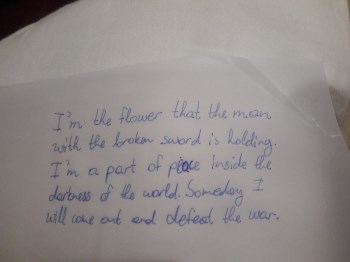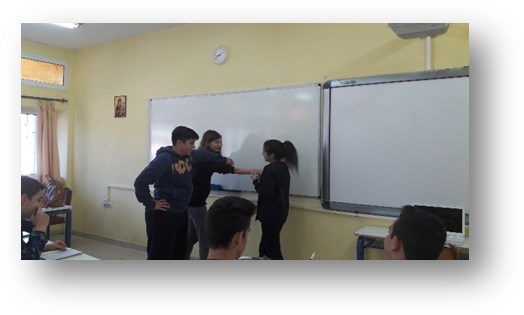Towards Building a Peaceful World
Maria Barberi, Greece
Maria Barberi holds an MA in Comparative Literature from U.E.A, U.K, and works as an EFL teacher at the state secondary school of Mandra, Greece. She is interested in Literature, the Arts including music, creative writing, storytelling, global and social issues while she is currently actively involved in European school projects. E-mail: mabarberi@gmail.com
Menu
Lesson plan
Creativity
Aims
- To develop students’ critical and creative thinking skills.
- Το motivate students to reflect on their own understanding of peace by creating their own poems.
- Identify their personal feelings and attitudes towards issues of peace and conflict by participating in two game like experiential activities.
- To evaluate and suggest solutions to conflicts.
Language focus
- To learn vocabulary related to conflict issues and the resolution of conflicts.
- To mainly practice expressing and justifying their own opinions “I think...” , “I think …because”
- To suggest solutions to conflicts “I suggest…”, “A good idea would be…”
Previous knowledge
- Students are familiar with haiku poetry and have practiced writing haiku poems in the past
- Students are familiar with Picasso’s Guernica and the history behind the painting
Class profile
A class of 25 students of lower secondary state school , aged 15
Level
B1-B2 (CEFR)
Time
45 minutes
Aids
Power point, large sheets of paper, (I used rice paper), internet access
Stage 1
After closely observing Guernica, we talked about the figures and shapes that compose it. We also talked about the possible sounds that we hear when we look at it, and brainstormed on the dramatic consequences of the war. The language used here is “ I see..” , “I think it is..” , “I hear…” Students answers were written on the board.
In order to delve deeper into the meaning of the painting, we used a technique called “Circle of Viewpoints” derived from Visible Thinking techniques developed by Harvard. According to this particular thinking routine, students are asked to choose a character, object or animal in the painting and speak about the topic from the perspective and viewpoint of that character, object or animal. They, then, have to ask a question from their chosen viewpoint. The writing frame for this activity is: “I am…”, “I think…”, “a question I have from this viewpoint is…” This technique is suitable for opening discussions on provocative issues such as the issue of war. It also helps students empathize with what a painting depicts, and express themselves freely and creatively.
Examples of students’ work

“I am the bull. I think of chaos, war and massacre. No one will survive. Everything will fall and die. The earth will be painted red by the blood that is spilt. Everyone around me is sad, devastated. I can see it in their eyes. A question I have to ask from this point of view is, why would this be happening? Why should people die because of an idea?”
Follow up
As a follow up to this activity students were assigned to find paintings of war or peace, write haiku poems about them, put up the poems and the paintings on Edmodo, an electronic platform designed for this project. The other students could add a comment on the poem or simply press “like”.
Examples of students work inspired by Magritte’s painting “The great grief”
Clear blue sky and sea
Feeling of freedom and peace
masks great war of grief
Maria Theodosi
Stage 2
For this activity, a sign that said PEACE was placed on one side of the classroom while on the other side of the classroom a sign that said NOT PEACE was placed. The teacher read various conflict scenarios. The students had to decide whether each scenario represented PEACE or NOT PEACE for them. Students expressed their opinion by silently moving to one side of the room or the other. If the situation could be identified as neuter, then, students stood somewhere in the middle. In the beginning of the activity, students moved around the room and mingled. The teacher can use music at this point. Once the teacher said “freeze”, or the music stopped, they had to stop moving, and a scenario was read to them; they, then, had to choose which side of the room they felt like they wanted to move towards to more. They were asked to reflect on why they chose to stand where they stood and give a justification for their choice of place. The scenarios referred to personal, local or international peace/non peace situations. Table 1 includes examples of such scenarios.
| Examples of peace/non peace scenarios |
| Personal |
- You think your teacher has been unfair in grading your test. You think your grade should be higher.
- You and a friend get in a fight, and your brother sits you both down to talk it out.
|
| Local |
- A high school hires armed security guards to manage school violence.
- Youth in a crime area participate in a local antiviolence programme.
|
| International |
- Young leaders from around the world, participate in a conference to learn about how they can contribute to local and global peace.
- There are 300,000 child soldiers involved in conflicts around the world.
|
The teacher can manage the time by presenting the students with as many scenarios as time allows.
The whole activity was followed by a discussion stage where students were asked to ponder on the essential ingredients for peace to exist or whether responding to conflict with violence can lead to a resolution. During discussion, new useful words like negotiation, good-will, and justice were elicited. All thoughts and words were written on the board.
Stage 3
The activity I am going to describe, is based on non-verbal communication. It is in fact a “visual dialogue”. The participants are not allowed verbal communication, nor symbolic gestures. They, instead, have to form a frozen image, a tableaux vivant, using their bodies. The image can represent a problem. It serves as a springboard for critical group reflection on the part of the audience who are asked to change it and suggest solutions to the problem.
In our case, students were invited to get in groups. They were given conflict scenarios. They were then invited to represent the conflict scenarios using their bodies in order to form static images. One of the groups decided to represent a conflict over land dispute. The first image pictured two people with clenched fists ready to fight. The second picture the students formed, showed the fight escalating. One of them had her arm stretched ready to give a punch to the other. The viewers recognized the conflict situation between the two people; they, then, were asked to intervene and change the image. One student got up, touched the aggressive hand and put it down. Finally, the class reflected on the whole scene expressing their views. “Aggressiveness is not the solution”. Other students suggested the “two sides enter a negotiation process”. Others suggested justice should intervene and “allot a fair piece of land to both parties”. Teacher posed a further problem. What if nothing of the above solved the problem? What if justice was unfair? Would conflict be necessary? Sometimes questions were posed and answers were not given. What proved important in this project was to reflect on questions. By reflecting on questions students develop critical and creative thinking and are motivated to think more deeply.


I work as an English language teacher for a State Secondary School in Greece teaching young teenagers. The framework of the Greek educational system as it is, offers teachers the opportunity to develop new ideas and projects since it allows for considerable independence giving only rough guidelines as to what it has to be taught in the course of the three year curriculum concerning foreign languages.
For me, being creative is building a dynamic relationship with everyday reality. Transforming it in a unique way so that you avoid stagnation. It is this perception that characterizes my personality. Becoming a teacher has given me ample space to channel my creativity. In my teaching career I have experimented with various new approaches tailoring them so that they cater for the unique needs of individual students.
I started implementing creative writing in my classrooms years ago using visuals and literary texts that functioned as stimuli, looking for motivating ways to approach the materials. The literary products of the latest creative writing project, which was also a small scale classroom research project, were published on a wiki electronic platform created to serve the aims of the project. Interactive storytelling, experiential learning activities to help build self- esteem, and drama improvisation are among the projects I have developed in the past. In my teaching I also incorporate elements of play, music, as well as extensive use of ICT. My students have also contributed to a large degree in finding new ways to promote aspects of the Greek culture in the framework of multilateral European projects collaborating with students from other European countries.
What I am currently interested in, is adopting creative approaches to teaching global issues; part of the project on global issues and conflicts in the form of a lesson plan is what I submitted for the C-group Bonnie Tsai scholarship competition. One of the poems my students have written for the specific project has already been published in the Hands Up Project webpage https://handsupproject.org/2017/07/09/5775/
For me, experimentation is the key word for any creative endeavor. For one thing, experimenting has helped me gain new insights into how my students learn or prefer to learn and has allowed me to explore my reactions as a teacher. Being open and tolerant to the creative outcome of the students’ work and suggesting ways of improving it, has led me into acquiring new knowledge of the behaviour the teacher should adopt in order to promote creativity among teenage students. The whole process of implementing innovative ideas and testing their results prompted critical self- reflection and a culture of dialogue and cooperation, qualities which are central to the development of the personality of both teachers and learners.
In the future I would also like to combine teaching with my second quality that of the musician. An idea that I would like to realize is to compose music for a storytelling project with short stories that I have written and which will be designed and performed by me.

Please check the Creative Methodology for the Classroom course at Pilgrims website.
Please check the Methodology and Language for Secondary course at Pilgrims website.


|